My Linguistic Journey: Exploring Arabic and English Languages
VerifiedAdded on 2023/06/04
|6
|1318
|70
Essay
AI Summary
This essay provides a personal reflection on the author's experience with two languages: Arabic, their first language, and English, their second language. The author details their acquisition of Arabic through socialization and family interaction, highlighting the cultural significance of the language. They then recount their experience learning English for schooling purposes, discussing the challenges of adapting to a new language environment in the United States. The essay emphasizes the power of language in shaping social identity and the difficulties faced when lacking proficiency in a dominant language. The author reflects on the emotional impact of these experiences and underscores the importance of language competence for integration and intercultural understanding, concluding with a call for the importance of learning multiple languages in a globalized world.
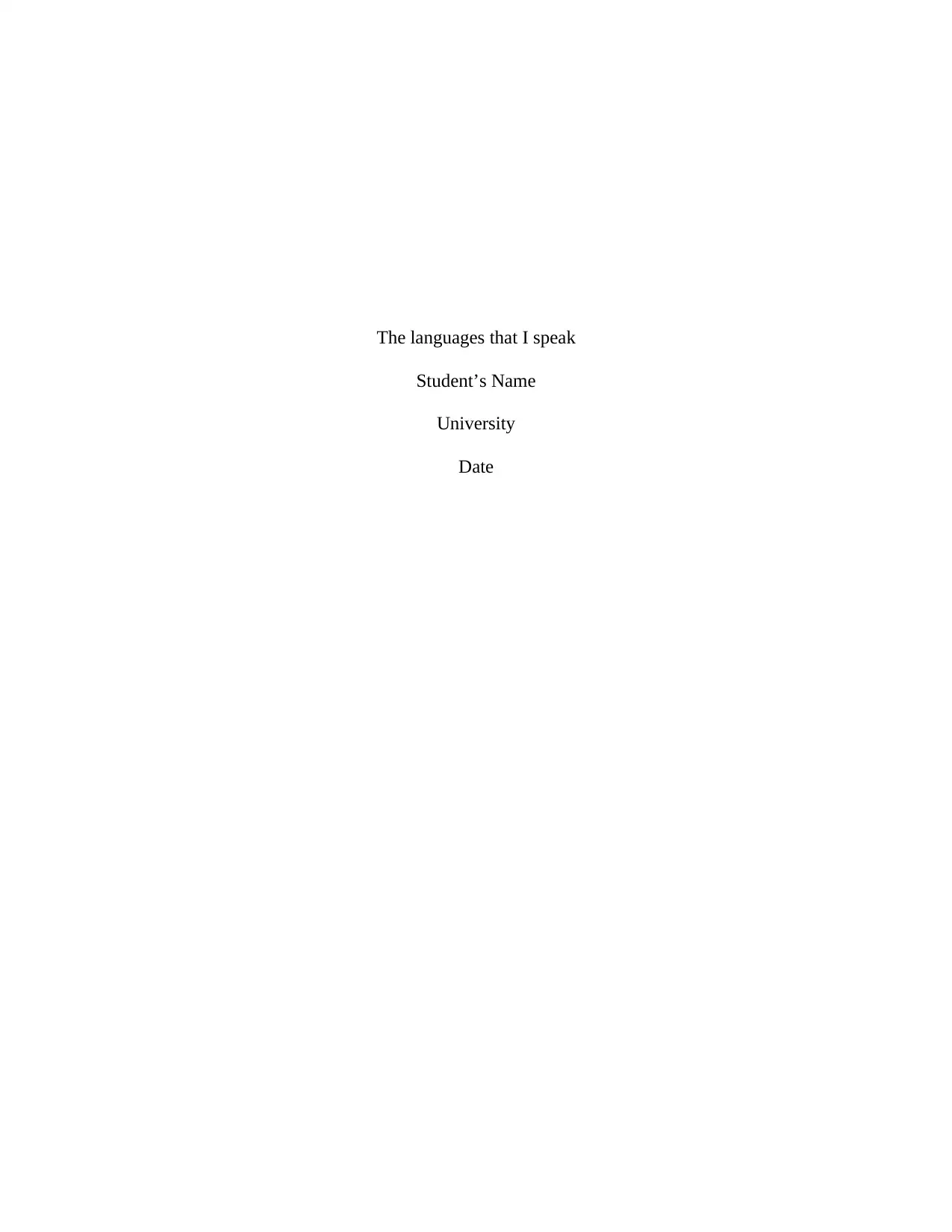
The languages that I speak
Student’s Name
University
Date
Student’s Name
University
Date
Paraphrase This Document
Need a fresh take? Get an instant paraphrase of this document with our AI Paraphraser
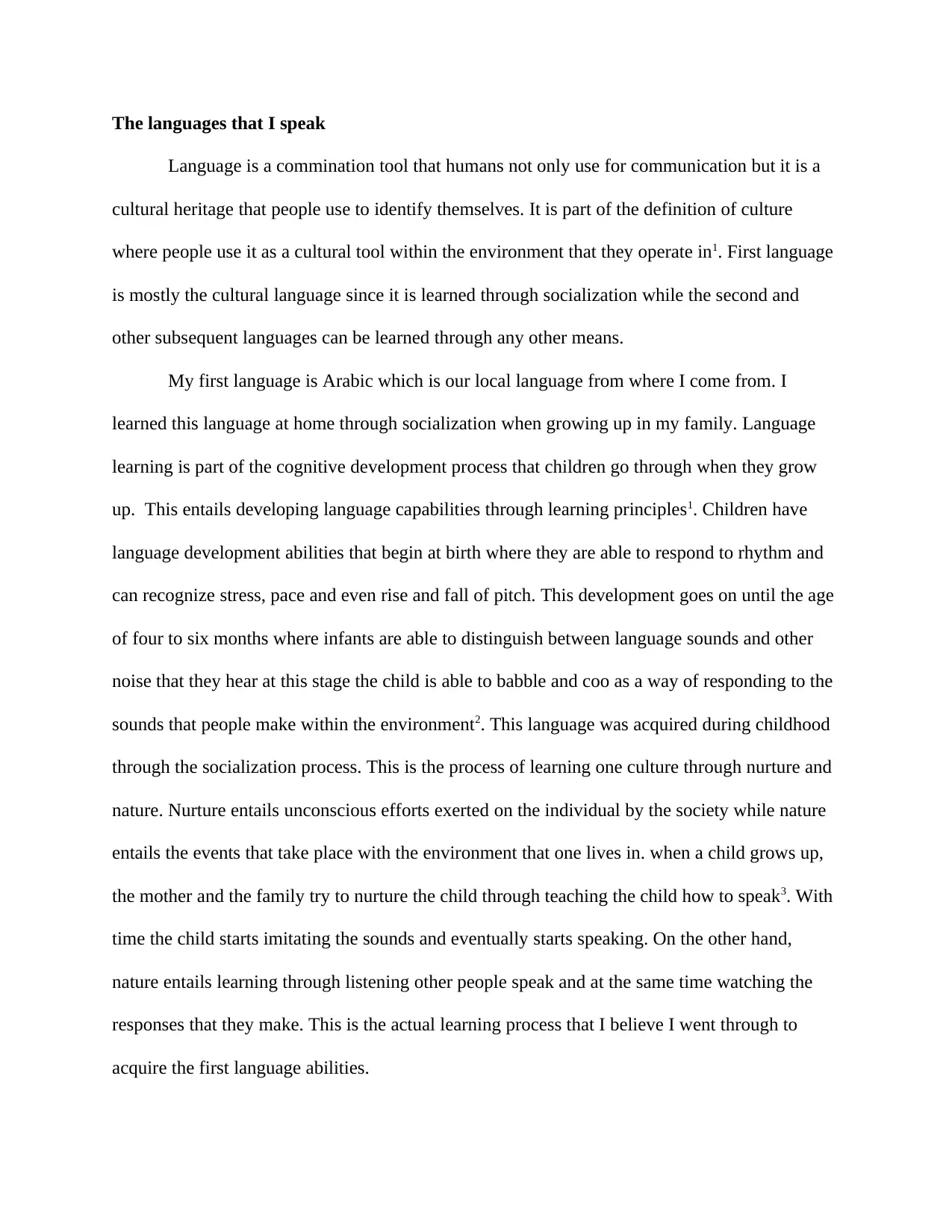
The languages that I speak
Language is a commination tool that humans not only use for communication but it is a
cultural heritage that people use to identify themselves. It is part of the definition of culture
where people use it as a cultural tool within the environment that they operate in1. First language
is mostly the cultural language since it is learned through socialization while the second and
other subsequent languages can be learned through any other means.
My first language is Arabic which is our local language from where I come from. I
learned this language at home through socialization when growing up in my family. Language
learning is part of the cognitive development process that children go through when they grow
up. This entails developing language capabilities through learning principles1. Children have
language development abilities that begin at birth where they are able to respond to rhythm and
can recognize stress, pace and even rise and fall of pitch. This development goes on until the age
of four to six months where infants are able to distinguish between language sounds and other
noise that they hear at this stage the child is able to babble and coo as a way of responding to the
sounds that people make within the environment2. This language was acquired during childhood
through the socialization process. This is the process of learning one culture through nurture and
nature. Nurture entails unconscious efforts exerted on the individual by the society while nature
entails the events that take place with the environment that one lives in. when a child grows up,
the mother and the family try to nurture the child through teaching the child how to speak3. With
time the child starts imitating the sounds and eventually starts speaking. On the other hand,
nature entails learning through listening other people speak and at the same time watching the
responses that they make. This is the actual learning process that I believe I went through to
acquire the first language abilities.
Language is a commination tool that humans not only use for communication but it is a
cultural heritage that people use to identify themselves. It is part of the definition of culture
where people use it as a cultural tool within the environment that they operate in1. First language
is mostly the cultural language since it is learned through socialization while the second and
other subsequent languages can be learned through any other means.
My first language is Arabic which is our local language from where I come from. I
learned this language at home through socialization when growing up in my family. Language
learning is part of the cognitive development process that children go through when they grow
up. This entails developing language capabilities through learning principles1. Children have
language development abilities that begin at birth where they are able to respond to rhythm and
can recognize stress, pace and even rise and fall of pitch. This development goes on until the age
of four to six months where infants are able to distinguish between language sounds and other
noise that they hear at this stage the child is able to babble and coo as a way of responding to the
sounds that people make within the environment2. This language was acquired during childhood
through the socialization process. This is the process of learning one culture through nurture and
nature. Nurture entails unconscious efforts exerted on the individual by the society while nature
entails the events that take place with the environment that one lives in. when a child grows up,
the mother and the family try to nurture the child through teaching the child how to speak3. With
time the child starts imitating the sounds and eventually starts speaking. On the other hand,
nature entails learning through listening other people speak and at the same time watching the
responses that they make. This is the actual learning process that I believe I went through to
acquire the first language abilities.
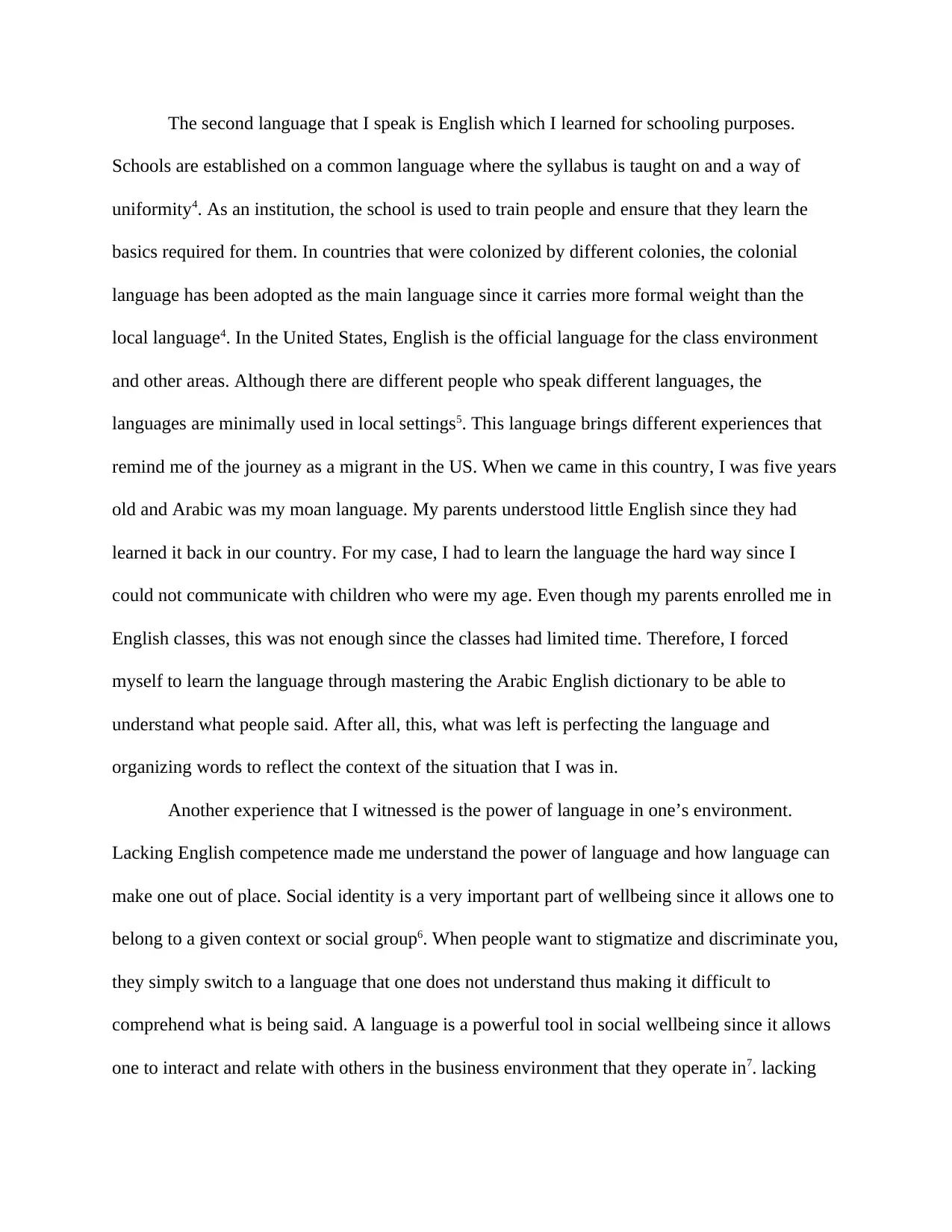
The second language that I speak is English which I learned for schooling purposes.
Schools are established on a common language where the syllabus is taught on and a way of
uniformity4. As an institution, the school is used to train people and ensure that they learn the
basics required for them. In countries that were colonized by different colonies, the colonial
language has been adopted as the main language since it carries more formal weight than the
local language4. In the United States, English is the official language for the class environment
and other areas. Although there are different people who speak different languages, the
languages are minimally used in local settings5. This language brings different experiences that
remind me of the journey as a migrant in the US. When we came in this country, I was five years
old and Arabic was my moan language. My parents understood little English since they had
learned it back in our country. For my case, I had to learn the language the hard way since I
could not communicate with children who were my age. Even though my parents enrolled me in
English classes, this was not enough since the classes had limited time. Therefore, I forced
myself to learn the language through mastering the Arabic English dictionary to be able to
understand what people said. After all, this, what was left is perfecting the language and
organizing words to reflect the context of the situation that I was in.
Another experience that I witnessed is the power of language in one’s environment.
Lacking English competence made me understand the power of language and how language can
make one out of place. Social identity is a very important part of wellbeing since it allows one to
belong to a given context or social group6. When people want to stigmatize and discriminate you,
they simply switch to a language that one does not understand thus making it difficult to
comprehend what is being said. A language is a powerful tool in social wellbeing since it allows
one to interact and relate with others in the business environment that they operate in7. lacking
Schools are established on a common language where the syllabus is taught on and a way of
uniformity4. As an institution, the school is used to train people and ensure that they learn the
basics required for them. In countries that were colonized by different colonies, the colonial
language has been adopted as the main language since it carries more formal weight than the
local language4. In the United States, English is the official language for the class environment
and other areas. Although there are different people who speak different languages, the
languages are minimally used in local settings5. This language brings different experiences that
remind me of the journey as a migrant in the US. When we came in this country, I was five years
old and Arabic was my moan language. My parents understood little English since they had
learned it back in our country. For my case, I had to learn the language the hard way since I
could not communicate with children who were my age. Even though my parents enrolled me in
English classes, this was not enough since the classes had limited time. Therefore, I forced
myself to learn the language through mastering the Arabic English dictionary to be able to
understand what people said. After all, this, what was left is perfecting the language and
organizing words to reflect the context of the situation that I was in.
Another experience that I witnessed is the power of language in one’s environment.
Lacking English competence made me understand the power of language and how language can
make one out of place. Social identity is a very important part of wellbeing since it allows one to
belong to a given context or social group6. When people want to stigmatize and discriminate you,
they simply switch to a language that one does not understand thus making it difficult to
comprehend what is being said. A language is a powerful tool in social wellbeing since it allows
one to interact and relate with others in the business environment that they operate in7. lacking
⊘ This is a preview!⊘
Do you want full access?
Subscribe today to unlock all pages.

Trusted by 1+ million students worldwide
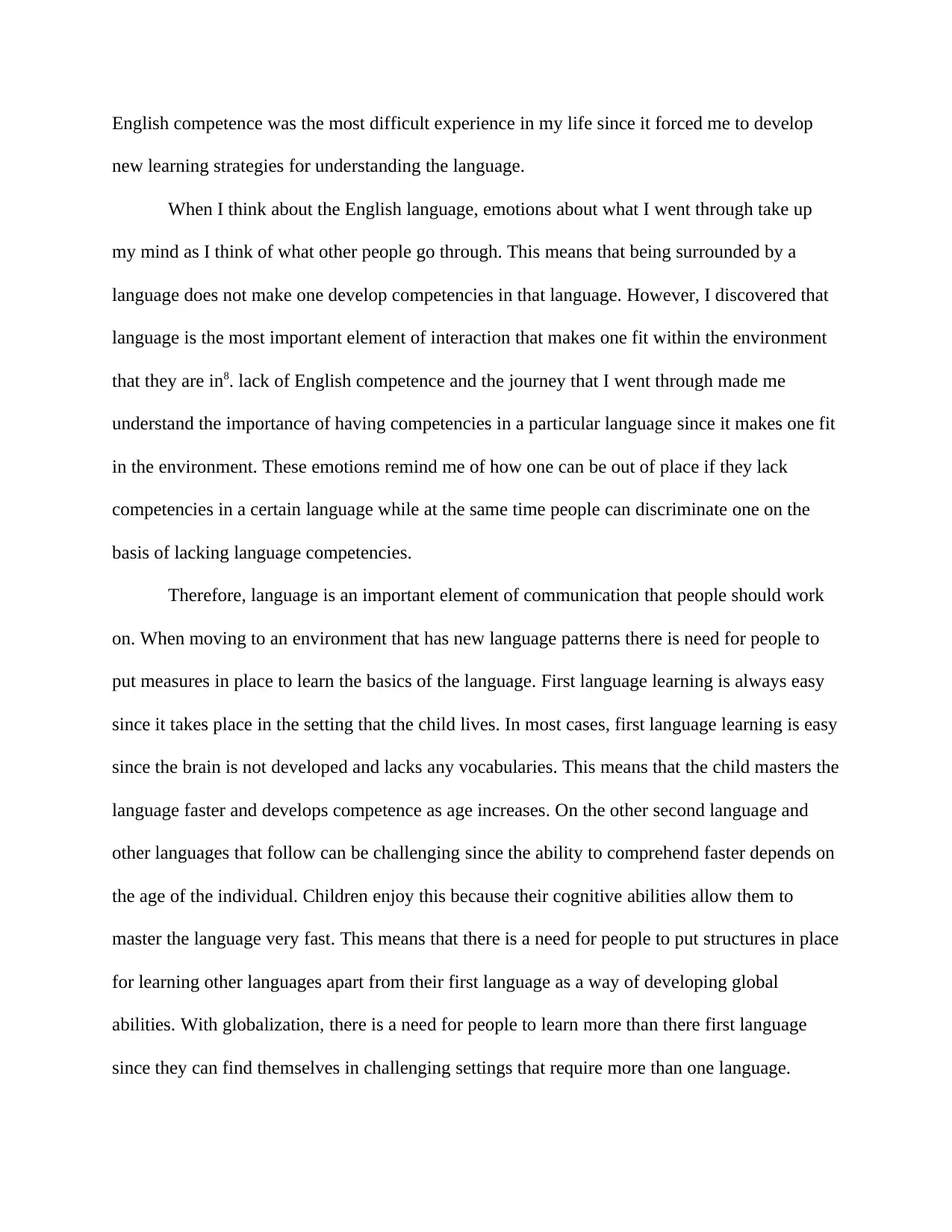
English competence was the most difficult experience in my life since it forced me to develop
new learning strategies for understanding the language.
When I think about the English language, emotions about what I went through take up
my mind as I think of what other people go through. This means that being surrounded by a
language does not make one develop competencies in that language. However, I discovered that
language is the most important element of interaction that makes one fit within the environment
that they are in8. lack of English competence and the journey that I went through made me
understand the importance of having competencies in a particular language since it makes one fit
in the environment. These emotions remind me of how one can be out of place if they lack
competencies in a certain language while at the same time people can discriminate one on the
basis of lacking language competencies.
Therefore, language is an important element of communication that people should work
on. When moving to an environment that has new language patterns there is need for people to
put measures in place to learn the basics of the language. First language learning is always easy
since it takes place in the setting that the child lives. In most cases, first language learning is easy
since the brain is not developed and lacks any vocabularies. This means that the child masters the
language faster and develops competence as age increases. On the other second language and
other languages that follow can be challenging since the ability to comprehend faster depends on
the age of the individual. Children enjoy this because their cognitive abilities allow them to
master the language very fast. This means that there is a need for people to put structures in place
for learning other languages apart from their first language as a way of developing global
abilities. With globalization, there is a need for people to learn more than there first language
since they can find themselves in challenging settings that require more than one language.
new learning strategies for understanding the language.
When I think about the English language, emotions about what I went through take up
my mind as I think of what other people go through. This means that being surrounded by a
language does not make one develop competencies in that language. However, I discovered that
language is the most important element of interaction that makes one fit within the environment
that they are in8. lack of English competence and the journey that I went through made me
understand the importance of having competencies in a particular language since it makes one fit
in the environment. These emotions remind me of how one can be out of place if they lack
competencies in a certain language while at the same time people can discriminate one on the
basis of lacking language competencies.
Therefore, language is an important element of communication that people should work
on. When moving to an environment that has new language patterns there is need for people to
put measures in place to learn the basics of the language. First language learning is always easy
since it takes place in the setting that the child lives. In most cases, first language learning is easy
since the brain is not developed and lacks any vocabularies. This means that the child masters the
language faster and develops competence as age increases. On the other second language and
other languages that follow can be challenging since the ability to comprehend faster depends on
the age of the individual. Children enjoy this because their cognitive abilities allow them to
master the language very fast. This means that there is a need for people to put structures in place
for learning other languages apart from their first language as a way of developing global
abilities. With globalization, there is a need for people to learn more than there first language
since they can find themselves in challenging settings that require more than one language.
Paraphrase This Document
Need a fresh take? Get an instant paraphrase of this document with our AI Paraphraser

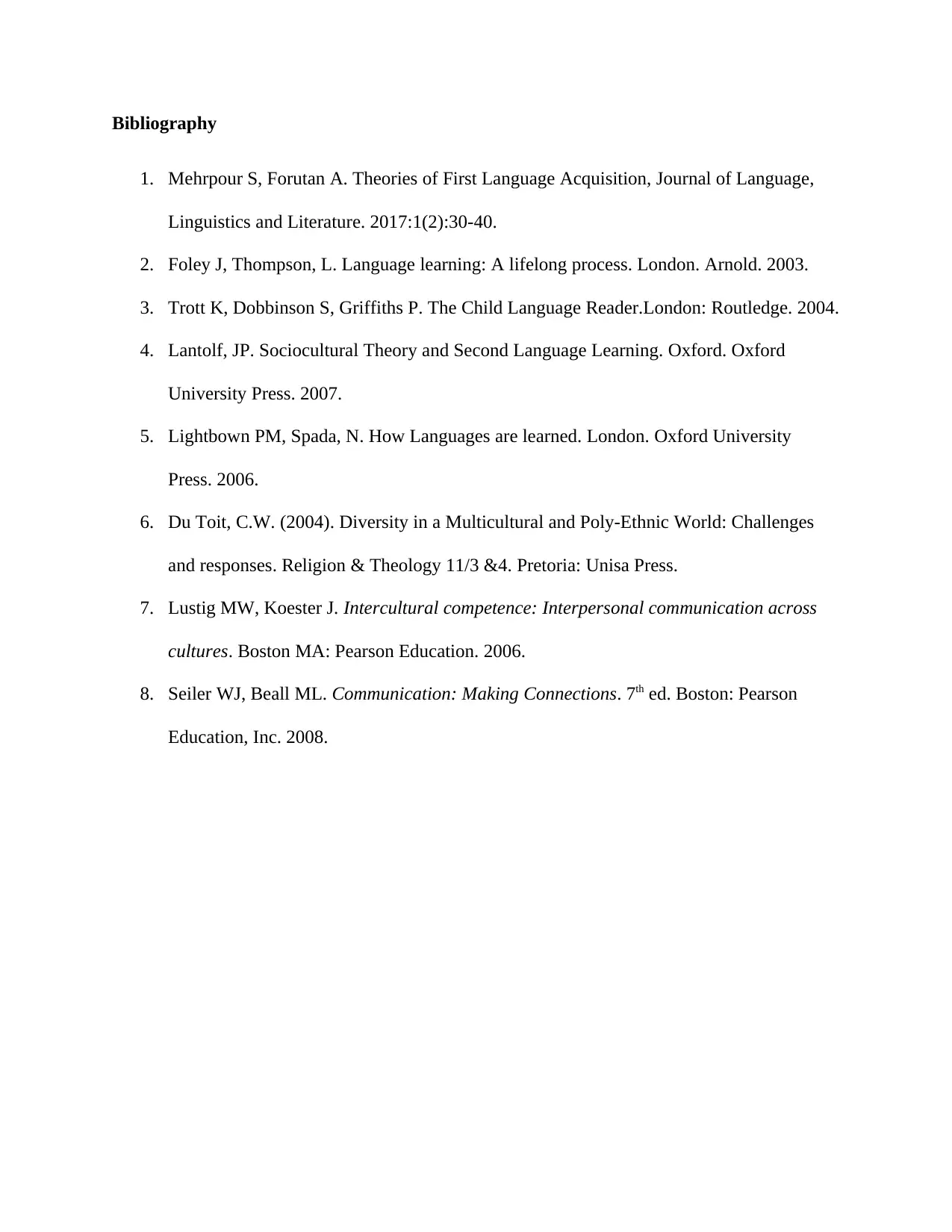
Bibliography
1. Mehrpour S, Forutan A. Theories of First Language Acquisition, Journal of Language,
Linguistics and Literature. 2017:1(2):30-40.
2. Foley J, Thompson, L. Language learning: A lifelong process. London. Arnold. 2003.
3. Trott K, Dobbinson S, Griffiths P. The Child Language Reader.London: Routledge. 2004.
4. Lantolf, JP. Sociocultural Theory and Second Language Learning. Oxford. Oxford
University Press. 2007.
5. Lightbown PM, Spada, N. How Languages are learned. London. Oxford University
Press. 2006.
6. Du Toit, C.W. (2004). Diversity in a Multicultural and Poly-Ethnic World: Challenges
and responses. Religion & Theology 11/3 &4. Pretoria: Unisa Press.
7. Lustig MW, Koester J. Intercultural competence: Interpersonal communication across
cultures. Boston MA: Pearson Education. 2006.
8. Seiler WJ, Beall ML. Communication: Making Connections. 7th ed. Boston: Pearson
Education, Inc. 2008.
1. Mehrpour S, Forutan A. Theories of First Language Acquisition, Journal of Language,
Linguistics and Literature. 2017:1(2):30-40.
2. Foley J, Thompson, L. Language learning: A lifelong process. London. Arnold. 2003.
3. Trott K, Dobbinson S, Griffiths P. The Child Language Reader.London: Routledge. 2004.
4. Lantolf, JP. Sociocultural Theory and Second Language Learning. Oxford. Oxford
University Press. 2007.
5. Lightbown PM, Spada, N. How Languages are learned. London. Oxford University
Press. 2006.
6. Du Toit, C.W. (2004). Diversity in a Multicultural and Poly-Ethnic World: Challenges
and responses. Religion & Theology 11/3 &4. Pretoria: Unisa Press.
7. Lustig MW, Koester J. Intercultural competence: Interpersonal communication across
cultures. Boston MA: Pearson Education. 2006.
8. Seiler WJ, Beall ML. Communication: Making Connections. 7th ed. Boston: Pearson
Education, Inc. 2008.
⊘ This is a preview!⊘
Do you want full access?
Subscribe today to unlock all pages.

Trusted by 1+ million students worldwide
1 out of 6
Related Documents
Your All-in-One AI-Powered Toolkit for Academic Success.
+13062052269
info@desklib.com
Available 24*7 on WhatsApp / Email
![[object Object]](/_next/static/media/star-bottom.7253800d.svg)
Unlock your academic potential
Copyright © 2020–2025 A2Z Services. All Rights Reserved. Developed and managed by ZUCOL.





